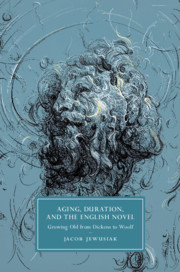Book contents
- Aging, Duration, and the English Novel
- Cambridge Studies in Nineteenth-Century
- Aging, Duration, and the English Novel
- Copyright page
- Dedication
- Contents
- Acknowledgments
- Abbreviations
- Introduction
- Chapter 1 Aging Theory
- Chapter 2 No Plots for Old Men
- Chapter 3 Life After the Marriage Plot
- Chapter 4 A Wrinkle in Time
- Chapter 5 The Technology Age
- Chapter 6 Gray Modernism
- Afterword
- Notes
- Bibliography
- Index
- Cambridge Studies in Nineteenth-Century
Chapter 5 - The Technology Age
Published online by Cambridge University Press: 14 November 2019
- Aging, Duration, and the English Novel
- Cambridge Studies in Nineteenth-Century
- Aging, Duration, and the English Novel
- Copyright page
- Dedication
- Contents
- Acknowledgments
- Abbreviations
- Introduction
- Chapter 1 Aging Theory
- Chapter 2 No Plots for Old Men
- Chapter 3 Life After the Marriage Plot
- Chapter 4 A Wrinkle in Time
- Chapter 5 The Technology Age
- Chapter 6 Gray Modernism
- Afterword
- Notes
- Bibliography
- Index
- Cambridge Studies in Nineteenth-Century
Summary
Focusing on H. G. Wells’s scientific romances, “The Technology Age” argues that the volatile modernity of Wells’s fiction pivots on a failure of sympathy between the young and the old. This failure generates the deeply ambivalent conditions by which generational antagonism arises alongside modernity’s technological and social progress. Drawing on the work of Charles Booth and tracts by the Fabian society, I illustrate how socialist arguments for a universal pension depend upon youths imagining the older person they one day will become. Analyzing works such as The Time Machine, War of the Worlds, Food of the Gods, and In the Days of the Comet, this chapter highlights the multitemporality of the banal process of aging. In this regard, science fiction provides insight into the reality of aging in a way that conventional literary realism cannot.
- Type
- Chapter
- Information
- Aging, Duration, and the English NovelGrowing Old from Dickens to Woolf, pp. 114 - 136Publisher: Cambridge University PressPrint publication year: 2019

